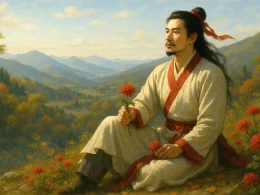What fills a monk’s day, you ask?
Sweeping floors, lighting incense—such his task.
Clear chimes pierce emerald peaks afar,
Idle clouds drift through bamboo bars.
Body and mind, beyond dust’s trace,
Time stretches long in this still space.
At dusk, the meditation door swings shut—
No one but sunset’s glow, left to mutter.
Original Poem
「题崇福寺禅院」
崔峒
僧家竟何事,扫地与焚香。
清磬度山翠,闲云来竹房。
身心尘外远,岁月坐中长。
向晚禅堂掩,无人空夕阳。
Interpretation
This poem, Inscribed on Chongfu Monastery's Meditation Hall, was composed by the Tang poet Cui Dong during a visit to Chongfu Temple. Nestled in secluded mountains, the temple exuded tranquility and solemnity. Facing the meditation hall's serene solitude, the poet expressed admiration for monastic life and detachment from worldly turmoil. During the mid-to-late Tang period, scholar-officials—whether disillusioned by career setbacks or spiritual emptiness—often sought solace in mountain retreats and Buddhist temples, projecting their contemplative yearnings onto these sanctuaries of quiet cultivation. Cui Dong's poem reflects this cultural psyche and embodies his signature style: austere, solitary, and aloof from mundane concerns.
First Couplet: "僧家竟何事,扫地与焚香。"
Sēng jiā jìng hé shì, sǎo dì yǔ fén xiāng.
What fills the monks’ long hours, pray?
Sweeping floors and burning incense—nothing more.
The opening question, posed with deliberate simplicity, appears to describe mundane monastic chores. Yet beneath the surface lies a reverence for the purity of ascetic life, starkly contrasting with the chaos of officialdom. The understated tone elevates the sacred in the ordinary.
Second Couplet: "清磬度山翠,闲云来竹房。"
Qīng qìng dù shān cuì, xián yún lái zhú fáng.
Clear chimes pierce emerald peaks;
Idle clouds drift to bamboo halls.
Here, the monastery’s harmony with nature unfolds. The clear chimes (a Buddhist percussion instrument) and idle clouds weave a tapestry of stillness, where sound and silence coexist. The imagery—verdant mountains meeting unbounded sky—embodies the seamless unity of spiritual practice and the natural world.
Third Couplet: "身心尘外远,岁月坐中长。"
Shēn xīn chén wài yuǎn, suì yuè zuò zhōng cháng.
Body and mind—far from worldly dust;
Time itself slows in seated stillness.
This couplet distills the essence of meditation: detachment (far from worldly dust) and temporal dilation (time slows). The paradox of seated stillness elongating time reveals Zen’s power to transcend mundane rhythms, mirroring the poet’s yearning for inner expansion beyond society’s rush.
Fourth Couplet: "向晚禅堂掩,无人空夕阳。"
Xiàng wǎn chán táng yǎn, wú rén kōng xī yáng.
At dusk, the meditation hall’s doors close;
Empty courtyard—only sunset remains.
The finale crystallizes absolute quietude. The closed doors and empty courtyard frame a scene where human presence dissolves, leaving only the dying light. The sunset (夕阳), often symbolic of transience, here becomes an eternal witness to the void—an apt metaphor for the poet’s own contemplative solitude.
Holistic Appreciation
The poem’s six lines depict the daily rhythms and atmosphere of Chongfu Temple’s meditation hall. Its form is unembellished, its tone serene, yet its artistic conception soars beyond the mundane. The poet, in a state of quiet observation, creates a striking contrast between the secular and the spiritual: acts like "burning incense and sweeping the floor" may seem ordinary, but under the "chime’s echo in mountain hues" and "idle clouds by bamboo quarters," they take on the beauty of Zen. The latter three couplets are particularly striking—their imagery grows more ethereal, their emotions more detached. The line "body and mind far from worldly dust" could almost serve as the poem’s spiritual axis, embodying the poet’s longing to transcend earthly turmoil.
Though the poem never explicitly states the poet’s desire to stay or leave, every word reveals his admiration for the purity of monastic life. Beneath its calm and quiet surface lies an escape from—and reflection on—the weariness of worldly struggles. The verses are balanced yet natural, their depth of meaning showcasing Cui Dong’s signature style: clear, sparse, and quietly profound.
Artistic Merits
The poem begins with scenery, blending emotion into the landscape. Its technique of "movement within stillness, feeling within tranquility" paints a quintessential Tang-era portrait of a mountain temple at dusk. The language is plain yet steeped in Zen. Without a single direct commentary, it conveys layers of meaning through pure description—especially the couplet "body and mind far from worldly dust, / years and months lengthen in seated stillness," a masterstroke of austere elegance.
Within a compact frame, Cui Dong captures the temple, its monks, nature, and inner reflection, demonstrating his poetic mastery. It also reveals his dual identity as a Tang intellectual on the margins: his verse aspires to transcendence, yet carries an undercurrent of unresolved yearning.
Insights
This poem invites deep reflection on life’s choices and the heart’s true home. When the clamor of the world wearies us, perhaps a quiet corner of "bamboo quarters under idle clouds" or the chime’s echo amid mountain greenery offers the soul its rightful sanctuary. Through delicate brushstrokes of monastic routine, the poet delivers a profound philosophy: no matter how chaotic the external world, the mind can remain cool and clear. It is this quiet power that inspires us to seek a dwelling place for the spirit.
About the Poet

Cui Dong (崔峒, dates of birth and death unknown), a Tang Dynasty poet from Anping, Hebei, was active during the Dali era (766 - 779). Along with Sikong Shu, Lu Lun and others, he was known as one of the "Ten Talents of Dali." His poetry primarily consists of five-character regulated verse (wulü), characterized by an elegant and subtle style. The Complete Tang Poems preserves 48 of his works. His poetic style resembles Liu Changqing's but appears more solitary and austere, reflecting the transition from the vigorous grandeur of High Tang poetry to the introspective quality of Dali-era verse.











